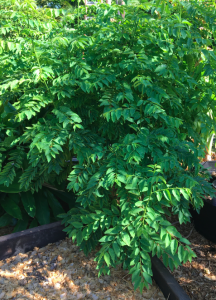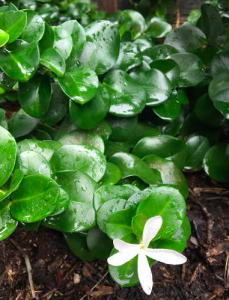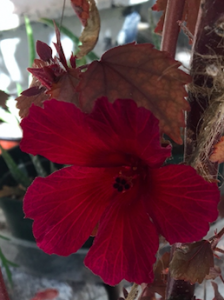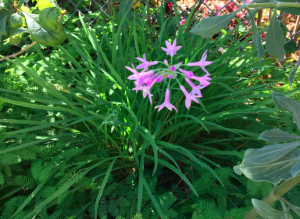Oftentimes we hear, “plant your ornamentals in the front yard and edibles in the backyard (so that nobody sees them)”, or “food plants always look scraggly”, but there are several very pretty edible plants that thrive in the heat of our summer, that not only look good, but gift us with flowers month after month. Even better: you can regularly trim them to fit your landscaping needs and eat the trimmings!
 Cranberry hibiscus
Cranberry hibiscus
There are a multitude of hibiscus varieties that grow very well in South Florida and are particularly beneficial for a vegetable gardener. Cranberry hibiscus is a common name of several varieties that share similar qualities: being edible, having distinctly red, purple or brownish foliage and red, pink, burgundy or maroon flowers. The leaves and flowers taste similar to French sorrel and can be used cooked or raw. This plant is very easy to propagate from either seeds or cuttings.
Roselle hibiscus
Roselle hibiscus is probably the most famous around the world for being used in red “carcade” tea. Flower calyces (the part enclosing the flower) are dried and made into a refreshing, vitamin-rich tea infusion. The leaves are eaten as a green vegetable, raw or cooked and have a slightly spicy flavor. Around the world, the plant has a plethora of common names and there are recipes for every taste. They are used in many different cuisines as it grows easily in warm climates and is cultivated prolifically in many continents. Like cranberry hibiscus, it grows well from both seeds and cuttings.
Ornamental hibiscuses aren’t edible and cannot be used for tea preparations.
 Society garlic
Society garlic
Onions and garlics aren’t that easy to grow in South Florida, but this relative of theirs is extremely useful in the kitchen in the heat of the Florida summer. Being native of South Africa, it is very heat and drought tolerant. It tastes similar to garlic or ramp greens with milder spiciness/odor, and has pretty blooms 8 months out of a year.
They can also form a sustainable border plant as an alternative to mondo grass – it has similar clumping nature and does not require irrigation. It’s propagated by simple clump division or from seed (a little more tedious).
 Katuk
Katuk
Katuk is a lovely shrub that comes in solid and variegated forms. It produces tiny red flowers and cute white berries almost year round, and can be easily shaped into an attractive landscape feature. It prefers partial shade but can also thrive in full sun when established. Leaves, flowers and berries are very rich in plant proteins and can be eaten instead of spinach. Propagate katuk by cuttings.
 Natal Plum
Natal Plum
In my opinion, natal plum has the most ornamentally appealing glossy foliage of all Florida natives. It’s a beautiful carefree shrub you can use as a privacy screen or a showpiece in itself. It grows slowly, so you wouldn’t need to trim it as often as you would Clusia or Ficus. Natal plum grows in full sun in a variety of soils. The foliage has deep green tropical color that rarely shows deficiencies. It has very fragrant white flowers with jasmine-like aroma and edible bright pink berries with mild sweet non-objectionable flavor. Propagate it by cuttings or simple layering.
If you decide to create an edible landscape, make sure your edibles are not sprayed with pesticides or herbicides, especially prior to consumption. Always follow instructions on pesticide and herbicide bottles.
More information on landscapes and gardens click here
All images for this blog post are taken by the author.
 4
4


